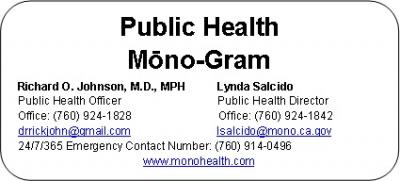Mono-Gram - Ebola: Update on Local Planning 11/07/2014
Ebola: Update on Local Planning
Much has happened in the last few weeks, so I thought I would update you on the status of our local planning efforts to respond to any person at risk for Ebola infection in our community.
There is always the danger of reassurance leading to complacency, but let’s be realistic about 3 risks:
- The risk of a person at high risk for Ebola arriving in one of our frontier rural communities, or of developing Ebola after arrival, is extremely low, but not zero.
- The risk of a person arriving here totally unannounced, without having previously been identified by federal authorities as a person at risk for Ebola, is extremely low, but not zero.
- The risk of first responders being exposed to lots of virus while unprotected is extremely low, but not zero.
Having said that, the concept of operations for our small rural communities with limited resources focuses on protection of all first responders and healthcare workers, and the safety of the community. The risk is low, but we must be fully prepared. After all, Ebola is a deadly disease.
DETECT
This begins with early detection of risk. All persons entering the US from the countries with ongoing transmission of EVD come in through one of 5 airports (JFK, Newark, Dulles, Atlanta, or O’Hare). There are about 3,000 per month. They receive enhanced entry screening and Check and Report Ebola (CARE) Kits before going on to their final destinations. 70% of them go to 6 states – California is not one of the 6. State and local health departments are automatically notified of the pending arrival of a person at risk. So far, 14 counties in California have been monitoring persons at risk: 1 defined at having “some risk”, and 13 with “low or no risk”. The goal of this program is to minimize the likelihood that a true suspect case would arrive by surprise.
Public Health will assign persons to one of 4 risk categories, based on their exposure or potential exposure to persons with Ebola disease. All persons will be given specific instructions to call the Health Officer or designee if they develop symptoms.
ISOLATE
Immediately upon identifying a person at risk who has now developed symptoms, they would be kept isolated. That is to say, any further close contact (within 3 feet) with family, friends, neighbors, and first responders should be avoided. If they are in a clinic or emergency department, they would be placed in a private room with bathroom facilities until staff are appropriately protected.
NOTIFY
The Health Officer or designee would be immediately contacted to perform an assessment of the situation, and to evaluate the risk to contacts, first responders, and the community. This would be done in consultation with state and federal officials. In addition, the local hospital where a person might be transported would be notified in order to have plenty of time to prepare for the arrival of this patient.
PROTECT
The only personnel who should approach a suspect patient are those with complete personal protective equipment (PPE), accompanied by repeated training and drilling so that they are competent and confident in the donning (putting on) and doffing (taking off) of the equipment. The highest risk time for contamination is during the doffing process. Very few of our first responder departments are so equipped and trained. Evaluation of a patient and transport will only occur after consultation with public health, and after determination that the person is at high enough risk of disease to warrant transport to a local hospital.
TEST AND INITIAL EVALUATION
Local hospitals will obtain a blood specimen to be sent by Public Health for testing for Ebola disease. They will start intravenous fluids, but other interventions will only occur under very carefully controlled situations by personnel with adequate PPE and training.
TRANSFER
If a test comes back positive for Ebola disease, the person will be transferred as soon as possible to one of the 5 University of California Medical Centers designated to treat Ebola patients (UC Davis, UC San Francisco, UCLA, UC Irvine, or UC San Diego).
QUARANTINE
Quarantine is the word used to describe how we handle persons who have been exposed but are currently well. For Ebola, all persons arriving from the 3 affected countries in West Africa who have potentially been exposed will be quarantined by the Health Officer for 21 days. Public health will monitor them for symptoms and fever every 12 hours, potentially restrict their movement to their home, and not allow travel via public transportation or in public places during this time. We will attempt to walk the fine line between personal rights and protection of the community.
Be assured that the risk is low, but we have been working diligently to prepare for even one potential patient. Our highest priority is protection of our first responders and all healthcare workers, followed by protection of the community as a whole. For more information and updates, go to www.cdc.gov/ebola


